Ryan Hall's Blog, page 264
April 21, 2016
To Eat or Not To Eat Before a Run

Photo: Shutterstock.com
Whether you’re looking to lose weight by running or looking to become more efficient at fuel consumption during a workout, fasted cardio is one way to train your body to tap into stored fat reserves. “Fasted cardio means you work out on an empty stomach—for example, first thing in the morning or after not eating for several hours, typically five hours or longer,” says John Heiss, PhD, who specializes in sports nutrition and as the senior director of product marketing at Herbalife. “The general thinking is that by not eating food, your body tends to burn stored fat for energy preferentially over the food you just ate.”
Although the concept of fasted cardio has been around for some time with much debate on its effectiveness, it’s recently becoming a popular fuel approach in endurance sports. Heiss says it could be especially beneficial for the average runner looking to lose weight and improve performance. However, much of how fasted cardio works depends on what your training goals are, what types of workouts you’re doing—i.e. high intensity interval training versus slower long runs—and how your body responds to it.
Metabolic Adaptation
First, it’s important to look at fasted cardio and fat burning in a long-term context of weekly calories in and out. “Looking at total calories burned, or the types of calories burned only during a workout window is over-simplifying the equilibrium of body composition,” Heiss explains. “A good example of this is high intensity interval training (HIIT), where athletes might do 10 maximal efforts lasting 20 seconds each with only 30 to 60 seconds rest in between. The total number of calories burning during this session is quite low, but long-term increase in metabolism is quite significant.”
“Mix It Up”
Not eating before a run depends on what kind of workout you plan on doing. Heiss stresses that having food before a workout isn’t going to undo the fat-burning effects and not eating beforehand won’t burn away fat either. “My advice is to mix it up. Eat before some workouts, and start out on an empty stomach for others,” he says. “There is a near-infinite number of biological differences that occur during exercise between the fasted and fed-states, and training both these metabolic pathways causes different desirable adaptations.”
For a low-intensity workout such as a 1-hour tempo run, eating less beforehand and shifting those calories to a post-workout shake or bar, enhances enzymes that are activated to burn fat efficiently.
But that doesn’t necessarily mean there aren’t advantages to eating before a run. “You can exercise at a higher intensity for longer, resulting in greater fitness and health gains in the long run. What matters more is an overall healthy eating pattern, and exercising regularly,” says Heiss, who has completed several ultras.
Burning Carbohydrates vs Burning Fat
Most runners consume carbohydrates pre-run or race for a substantial source of energy. Think pasta dinners the night before a marathon. However in a fasted cardio approach the emphasis is placed on burning fat. “From a performance angle, if you’re running a part of the course that isn’t super hard, then you can be burning fat and save your carbohydrate stores for when you need them at higher intensity,” Heiss explains. “This essentially gives your body a larger fuel tank of energy at its disposal.”
For actual race day performance though, you need to train your body to be efficient at burning both types of fuels: carbs and fats.
As you progress in training leading up to a race or race season, your training will typically shift from long, slow distance runs, to more specific, higher-intensity workouts. Your nutrition strategy should also be periodized in this manner, progressing from general to specific. Heiss suggests doing some early season slow runs fasted to allow your body to develop efficient fat-burning, and then adjust to fed training and carbohydrate intake during high-intensity sessions for maximal performance gains and recovery.
“For races marathon-distance and shorter, carbohydrates will be the primary energy your body uses,” Heiss says. “So it’s important to not completely neglect training in a fed state. For those doing ultra-events, this is where the performance angle of training both fasted and fed can have positive impacts.”
When it comes to the elite-level or sub-3-hour marathoner, though, Heiss explains, “Those guys want to burn entirely carbohydrates during a race and not fat because they can’t generate enough energy from fat fast enough to keep up with their power demands. The other complexity is that to burn fat it requires more oxygen then it does to burn carbohydrates and someone that’s running a 2:10 marathon, their biggest concern is oxygen supply.”
Getting Started
When teaching your body to adapt to a fasted cardio method, Heiss advises 1. Work up to running on an empty stomach by gradually increasing duration and to keep the intensity low, 2. Don’t start so hungry that you binge eat after a workout and consume more calories than burned, and 3. Have a good quality protein shake afterward.
*This information was recently presented at Herbalife’s first-ever Satellite Symposium that took place before the American Society of Nutrition’s annual conference in San Diego.
The post To Eat or Not To Eat Before a Run appeared first on Competitor.com.
Q&A: Sara Hall on the London Marathon, the Olympic Trials and More

Sara Hall in London (photo: Jane Monti/Race Results Weekly)
(c) 2016 Race Results Weekly, all rights reserved. Used with permission.
LONDON — Of the 21 athletes on the elite women’s start list for Sunday’s Virgin Money London Marathon, there is only one American: Sara Hall of Redding, Calif. The 33-year-old will be running in her fourth marathon and, as it was for her husband Ryan, she hopes that London’s fast course from Blackheath to The Mall will be kind to her.
Hall competed in the U.S. Olympic Trials Marathon in Los Angeles in February, but dropped out. She hit the halfway point in 1:15:12, but recorded her final split at the 17th mile (27th kilometer). Soon after the race, she decided to run London. She spoke to Race Results Weekly yesterday here.
Race Results Weekly: How did you end up in London’s elite field? Did you decide right after the Trials?
Sara Hall: Ryan and I were like, whoa, that really happened, that was a bad dream. What do we do now? Naturally, we were thinking about the track trials, but I felt like my heart was really in the marathon right now. I had such a beautiful build up that I want to do another. I want to learn the event better, and Ryan and I were both thinking this race. So, we were like, let’s go for it.
RRW: Why did you drop out at the Trials? Was it the heat?
SH: I don’t really know exactly. I was struggling kind of around halfway. Maybe the pace, with how hot it was, got to me. My muscles started cramping really bad. I had that happen at the L.A. Marathon the previous year. These were like so strong that they were stopping me. So, rather than run through it like I did there… the smartest thing for me to do was just stop. I think that was around about 17 1/2 (miles). That was the first race that I ever dropped out of. It was really hard. Mentally and stuff, it was hard to get over. But in some ways, being so far from making the team made it easier in a way.
RRW: Why London?
SH: Well, I definitely wanted to come somewhere cooler after two really extremely hot races I really underperformed in. So, London is usually reliably cooler. That was one of the reasons for coming here.
RRW: After every marathon, athletes and coaches analyze what went well and what went wrong. What did your analysis of the Trials show you?
SH: The main thing is that I have not been racing well in the heat recently, like pretty much across the board. It’s not just in races, but in training, too. So, like where we live it gets quite warm, and I’ll be consistently training well and then we hit a warm day. So that’s on me, to get better at it. I was trying before the Trial to do some things to acclimate, even though it was the dead of winter and it was pretty cold. I think that was the main thing.
RRW: You ran the IAAF World Half-Marathon Championships six weeks after the Trials, and you finished 15th (second American) in 70:58 in heavy rain. Did that performance demonstrate that you were on track to potentially run well at London?
SH: That was good just to get out there again and finish a race strong. It’s always nice, like at World Cross last year when I came off L.A. Marathon. I was like, I wasn’t delusional about my fitness (she finished 20th and was the top American). I am in good shape; it was just the conditions that really affected me. So, even though it wasn’t my fastest half, I felt like it was a good effort that got me back on track to being here.
RRW: What will be your approach to Sunday’s race?
SH: You know, it’s really just seeing what I’m capable of. I feel like I got a little taste of it in Chicago (last October when she ran a personal best 2:31:14 and finished 10th), but I really didn’t get a feel for it in my other races. So, kind of just that joy of going out there and pushing yourself and seeing what’s possible. I feel like I have no expectations of myself of the things I would like to accomplish, but I think it’s more like just focusing on that joy of just running with reckless abandon, without anything really on the line. It’s more for the joy of it that I’m here.
RRW: The larger than normal British field here (the race is the British Olympic Trial), should play to your advantage as there should be more women between the low 2:20’s and low 2:30’s than usual.
SH: I definitely am here to run with people. I’m a competitor and I always do better when I’m competing. It can be a lonely race with some of these races when they get strung out, especially when the have rabbits going so fast up front. But, I hope there will be some people running around where I want to run.
RRW: Ryan was very successful in London. He ran his first really fast time here (2:06:17 in 2008). What advice did he give you about the course?
SH: He just says how magical it is here. And I saw it when I was here (with Ryan). One of the biggest reasons I’m here is just seeing it. I was like, I want to run this race someday. Somehow, some way, I want to be here. That’s part of the reason for doing it, just for the experience of it. He’s just encouraged me about how good the crowds are. He remembers the course well.
RRW: After you dropped out at L.A., didn’t you think about the Track Trials first? What did you want to go right to another marathon first?
SH: Obviously, like, it’s hard with the track trials. It was definitely a step away from that. I think I had to follow my gut, and Ryan’s gut, with it that this is what I was most passionate about. So, I want to keep pursuing this, you know? Then, I’m going to turn the corner and run track. The strength training from the marathon is actually going to really benefit me on the track. But, this obviously wasn’t a decision based on track.
RRW: Will you still compete in the Track Trials? What event?
SH: I’d love to run another 10K maybe before the Trials. I ran my first one (in a national championships) last June in another 90-degree race at the track nationals (she finished 12th in 34:03.25). But actually, even in the shorter stuff, 5K or steeple, my workouts that I have done before this have gone pretty well. So, I’m really open to anything. We’ll see how the workouts go.
RRW: So you’re really not sure yet…
SH: Not really, no. I’ll think once it’s my focus more I’ll know from my training and early racing. Because I’m going to get out there and race as soon as I can as soon as my body recovers.
The post Q&A: Sara Hall on the London Marathon, the Olympic Trials and More appeared first on Competitor.com.
April 20, 2016
The Faces of Boston: Amazing Images from the 2016 Boston Marathon
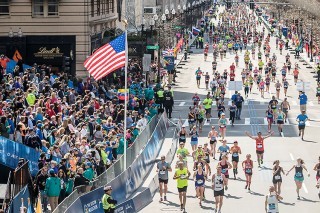
Photographer Kevin Morris spent Monday shooting photos at the 120th running of the Boston Marathon. Without further ado, here are some of the amazing images he captured.
Photo Gallery
1 of {count}
Back to Start
View Larger Image
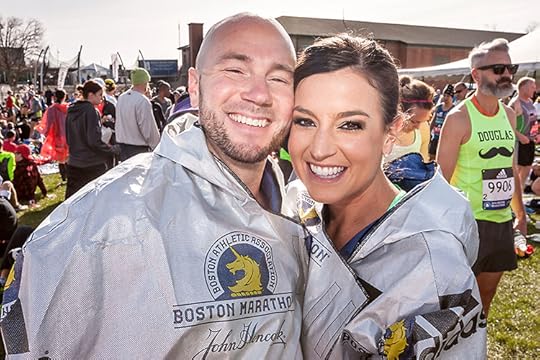
2016 Boston Marathon
To celebrate their one-year-to-the-day wedding anniversary, Ross Cockerham and Ansley Proctor huddle together in the athlete's village awaiting their start time.
View Larger Image
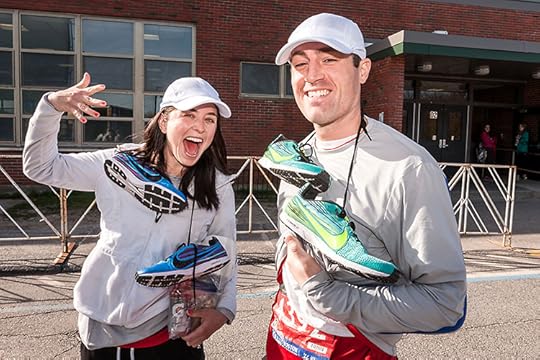
2016 Boston Marathon
Jacqueline Venneri and Nate Jowett take their Nikes and walk from the athlete's village to the starting corrals.
View Larger Image
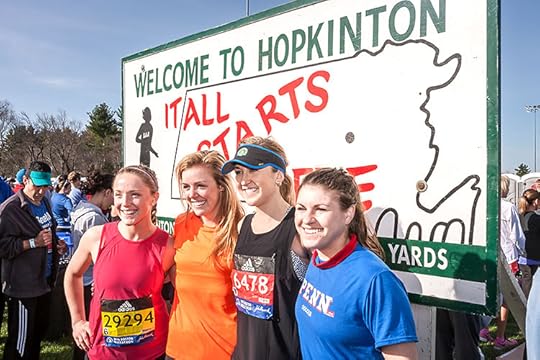
2016 Boston Marathon
Near the Boston Marathon start in Hopkinton, Mass., this iconic sign attracts runners wanting group portraits.
View Larger Image

2016 Boston Marathon
Bobbi Gibb is honored on the 50th anniversary of the first woman to run the Boston Marathon in 1966.
View Larger Image

2016 Boston Marathon
Offering mutual support in the athlete's village, George Redman and Dilico Oguilar await the start of their race.
View Larger Image

2016 Boston Marathon
Awaiting the crowds of runners passing by as they walk to the corrals for the start, a local Hopkinton family sets up on their lawn to enjoy the parade.
View Larger Image
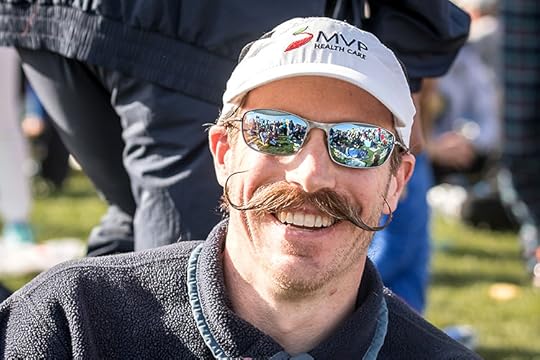
2016 Boston Marathon
David Monk is all smiles in the athlete's village before the race.
View Larger Image
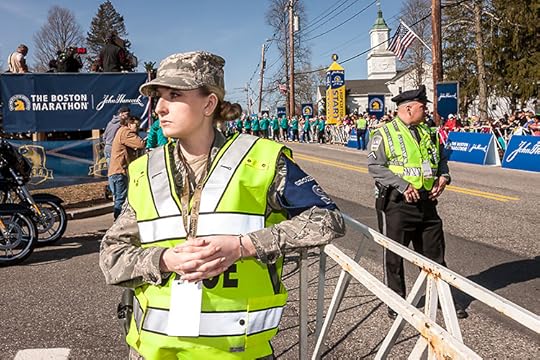
2016 Boston Marathon
Security is paramount at Boston, three years after terrorist bombings marred the race.
View Larger Image
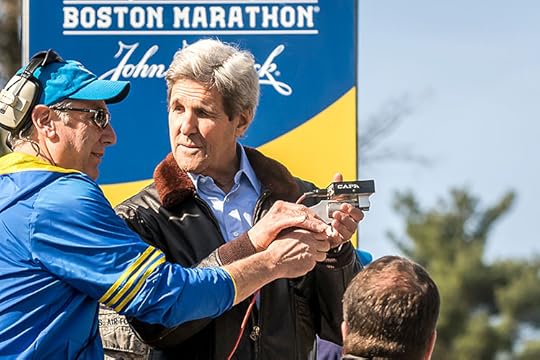
2016 Boston Marathon
U.S. Secretary of State John Kerry, a Massachusetts native, takes the starter's pistol from race director Dave McGillivray prior to sending the elite runners on their way.
View Larger Image
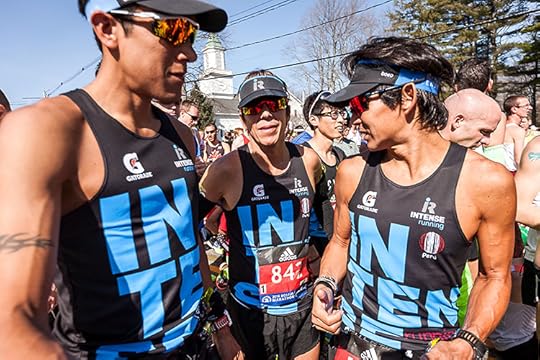
2016 Boston Marathon
A trio of Peruvian runners gets ready for their first run in Boston.
View Larger Image
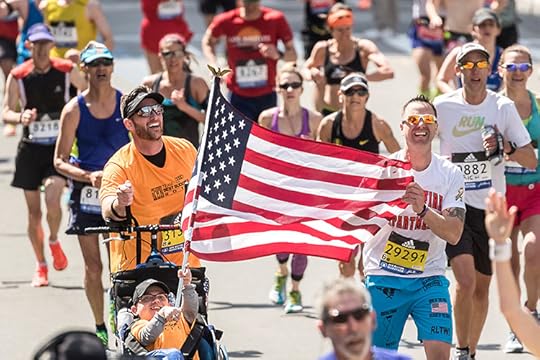
2016 Boston Marathon
Approaching the finish line, Lucas Carr helps unfurl the American Flag as Team Best Buddies pushes to the finish.
View Larger Image
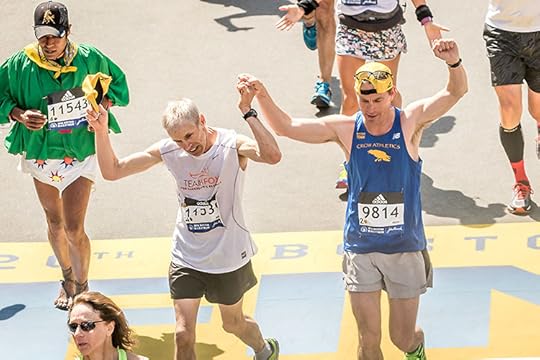
2016 Boston Marathon
Michael Westphal, 56, of Maine, finishes with his brother Rolf. Westphal suffers from Parkinson's disease , yet finds running quiets the symptoms.
View Larger Image
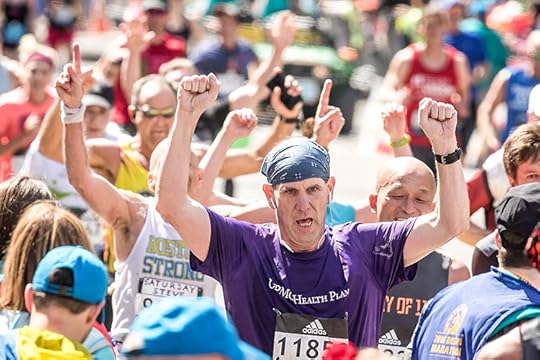
2016 Boston Marathon
Runners celebrate their finish on Boylston Street.
View Larger Image
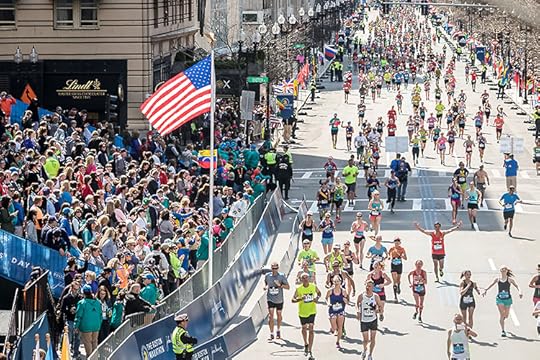
2016 Boston Marathon
Runners pass the American Flag just a few yards before crossing the finish line.
View Larger Image
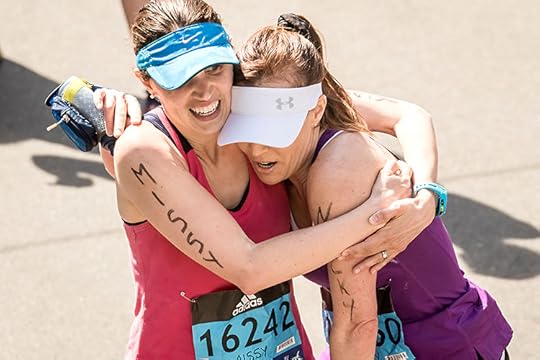
2016 Boston Marathon
Missy Cormier of Freeport, Maine, hugs a friend after they finish.
View Larger Image
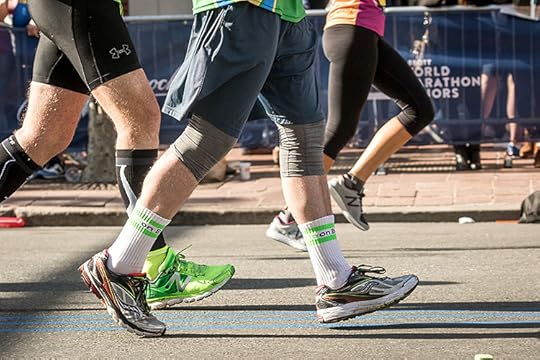
2016 Boston Marathon
In all, 26,639 runners finished the 120th Boston Marathon.
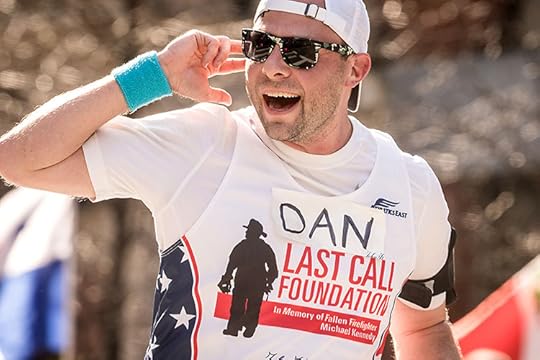
2016 Boston Marathon
A runner named "Dan" engages the crowd while running down Boylston Street to the finish line.
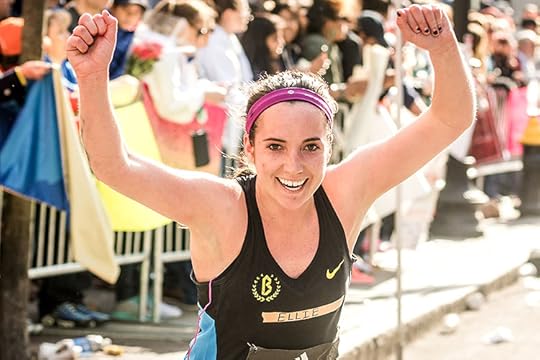
2016 Boston Marathon
A runner named Ellie gets a boost from seeing friends along Boylston Street.
View Larger Image
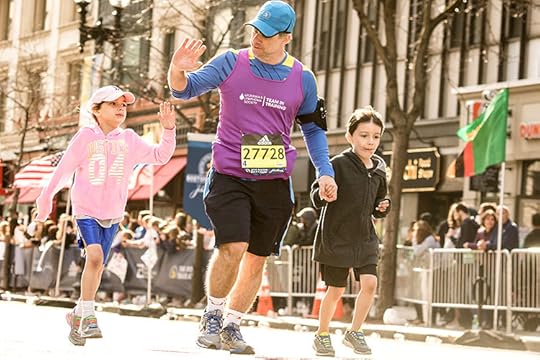
2016 Boston Marathon
James Fallon, 46, of Andover, Mass., finishes with his kids.
View Larger Image
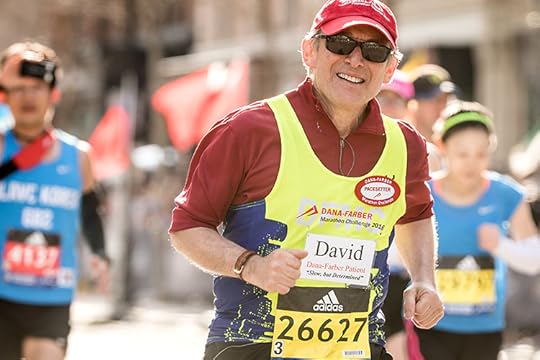
2016 Boston Marathon
David Hoffman, 69 of Acton, Mass., is all smiles as he nears the finish line.
View Larger Image

2016 Boston Marathon
Hafsa Labreche, 29, of Maynard, Mass., celebrates as she approaches the finish line.
View Larger Image
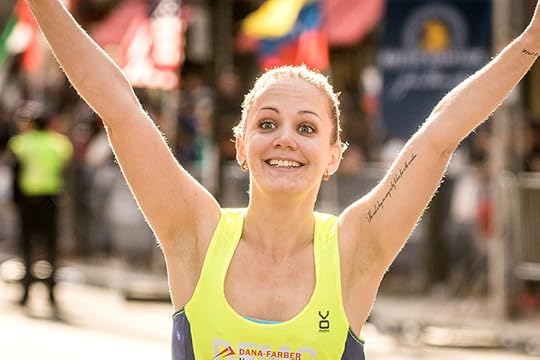
2016 Boston Marathon
"The road is long, we carry on, try to have fun in the meantime."
Related Galleries
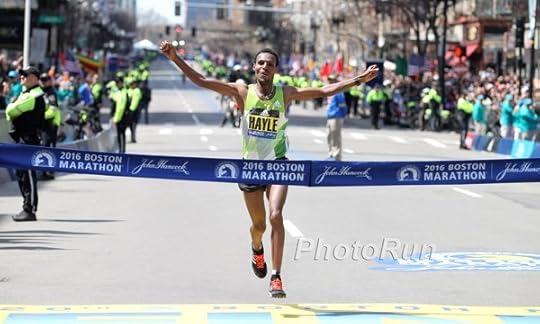
Photos: The 2016 Boston Marathon Elite Races
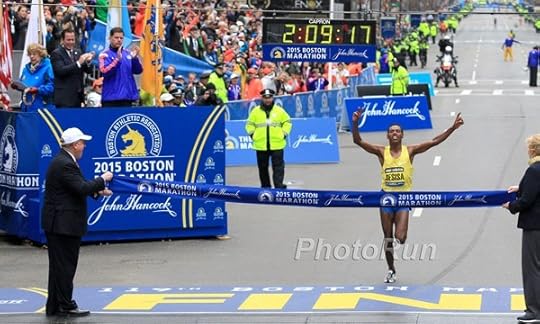
10 Elite Runners to Watch at The 2016 Boston Marathon
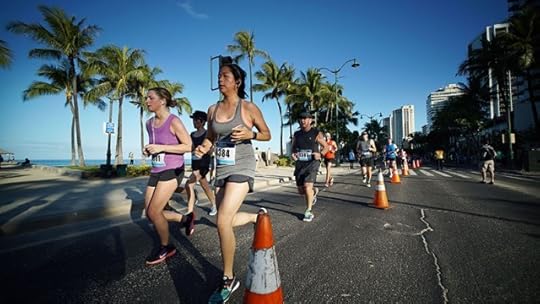
Photos: The 2016 Hapalua, Hawaii’s Half Marathon

Photos: 2016 Rock ‘n’ Roll Raleigh Marathon and 1/2

More Galleries
The post The Faces of Boston: Amazing Images from the 2016 Boston Marathon appeared first on Competitor.com.
Scout Bassett: Turning Failure Into Success
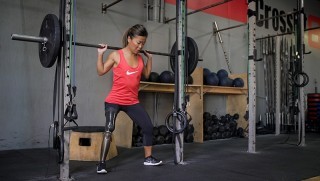
Scout Bassett is a fighter. The world-class triathlete and sprinter lost her leg to a fire in Nanjing, China, when she was a baby, and, after being adopted by a family in Michigan, has since become one of the most elite single amputee sprinters of our day. Watch the story of how she turned personal tragedy into athletic triumph as she strives for podium success this summer. Then look for Episode 2, coming soon.
The post Scout Bassett: Turning Failure Into Success appeared first on Competitor.com.
Video: Irish Runner Leads Relay Team To Victory With Crazy Finishing Kick!
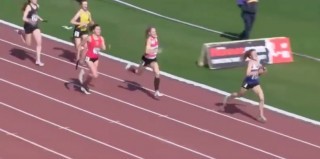
Watch—and listen—as 21-year-old Irish sprinter Phil Healy emerges from “the depths of hell” last weekend in the women’s 4x400m relay at the Irish Universities Track and Field Championships to bring her UCC team from fifth to first in the final 100 meters. Equally entertaining is commentator Cathal Dennehy’s call of the race.
The post Video: Irish Runner Leads Relay Team To Victory With Crazy Finishing Kick! appeared first on Competitor.com.
Why the Big Toe is a Big Part of Running
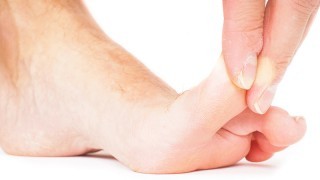
We give our core a lot of attention, and rightfully so. It stabilizes our spine, which in turn stabilizes our entire torso, and to a large extent our entire body.
But as renowned biomechanist Jay Dicharry sees it, every part of the body essentially has a core—joints, muscles and tendons that build a stable foundation for that area.
For the foot? That “core” is the big toe. And for runners, the big toe is a big deal.
“The big toe is responsible for approximately 80-85 percent of the stability in your foot,” says Dicharry, who wrote the book Anatomy for Runners. “Your lesser toes curl and lift off the ground, but the big toe’s job is to ground down and build a ‘tripod’ between the end of the toe, the inside ball of the foot and the outside ball of the foot.”
For several reasons, be it injuries or even minor running form issues, problems with the big toe can cause a chain reaction of problems on up the leg—from plantar fasciitis to Achilles problems to calf strains and more.
“When muscles inside the foot don’t work correctly, they pass a ton of strain up into the lower leg, to tissues that aren’t designed to bear the load,” Dicharry said. “Things break down.”
RELATED: How To Beat Achilles Tendinitis
What can cause an “underperforming” big toe? Dicharry notes sub-clinical problems with the feet can lead to an under-utilization of the big toe, which puts additional stress elsewhere. If you don’t take full advantage of your big toe’s designed use, you could have problems on up your legs.
Additionally, there are several toe injuries of note that can force problems on other parts of the foot and lower leg:
Hallux rigidus, which causes a stiff toe joint.
Hallux valgus, or a bunion, which is essentially a deviated joint.
Turf toe, a strain of the big toe joint.
Even lesser problems, like an ingrown toenail, can cause a pain-avoiding form tweak that could stress other parts of your leg.
If your big toe is causing you pain while you run, proceed with caution before you choose to train through it—or it could lead to injuries elsewhere.
If you do have persistent big toe pain, consider these ideas:
Rest. Always listen to your body.
It’s possible you have an imperfect shoe fit. Visit your local running store and talk to a specialist. Depending on the source of the pain, a shoe with a wider toe box may help ease the stress on your big toe.
If the problem persists, seek medical advice!
Running is a simple task on the surface, but it involves all sorts of moving parts to allow for leg movement, balance, push-off and more. The big toe plays a big part in you being a fine-tuned running machine—so take care of it.
“Fix the toe, fix the problem, fix the symptom,” Dicharry says.
RELATED: The 5 Most Troublesome Running Injuries
The post Why the Big Toe is a Big Part of Running appeared first on Competitor.com.
How Runners Can Train the Posterior Chain
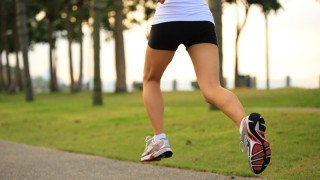
The posterior chain is our power house and is comprised of some of the biggest and strongest muscles in the body. These muscles, including those of the back, glutes, hamstrings and calves, are critical to all athletic movements, including running.
Why? The contracting of the posterior chain is what propels your body forward with each stride—the back muscles act to straighten and extend the spine; the glutes extend the hips and keep the femurs aligned; the hamstrings extend the hips and flex the knees (while also stabilizing the knee joints); and the calves extend the ankles and play a role in knee stabilization.
As runners, it’s easy for us to fall into a quad-dominant scenario, taking our hamstrings and glutes out of the picture or, at the very least, moving them to the back burner. Add to that the amount of time many of us spend sitting on our butts. In a sense, these posterior muscles forget how to work, forcing our anterior muscles to take over and do jobs they were never designed to do. This leads to a host of problems with reduced running performance and increased risk of injury topping the list.
How do you know if your posterior chain is weak? If you spend most of your day sitting, you can pretty much guarantee your posterior strength leaves something to be desired. If you regularly experience knee pain, your quad-to-hamstring ratio may need some improvement (i.e. stronger hamstrings). If you regularly experience back pain during runs or at rest, you may have tight, overdeveloped quads and hip flexors that are causing excessive anterior pelvic tilt and spinal lordosis (sway back). If your kick isn’t there or you feel your power is lacking, there’s a pretty good chance you’re not running on all cylinders.
The key to optimal stride efficiency and power is balance between the intricate system of the anterior and posterior chains. Because running is flexion dominant, adding extension exercises that target the posterior chain to your training will balance out the stress your body consistently endures. Work a few of the following moves into your routine to increase your power output and up your running game:
The post How Runners Can Train the Posterior Chain appeared first on Competitor.com.
Workout Of The Week: Brad Hudson’s 1-2-3-2-1 Fartlek

The 1-2-3-2-1 fartlek is an effective way to introduce multi-paced workouts into your training. Photo: www.shutterstock.com
A few years ago I had the privilege of collaborating with Brad Hudson on a training book entitled Run Faster from the 5K to the Marathon. Brad was a top runner back in his day, with a couple of 2:13 marathons on his resume, and is now a top coach based in Boulder, Colorado.
I learned a lot from working with Brad. One of the things I learned was the value of multi-pace workouts. Most workouts target one or, at most, two paces. For example, your typical long run is done at a single, steady pace. Your typical interval workout targets two paces: a fast interval pace and a slow warmup, recovery, and cooldown pace. But there’s good reason to perform some workouts that target three or more different paces.
Such workouts can be used to provide a small dose of running at several intensity levels when that’s what fits best into a given week of training, to train your ability to “change gears” during a hard effort, and to provide a literal change of pace in your training that is mentally refreshing yet also physically productive.
RELATED: The Short Fartlek
Brad’s 1-2-3-2-1 workout is perhaps my favorite multi-pace workout amongst the several he taught me. It is run by time rather than distance and is therefore conducive to being done on the roads, which is what it’s really designed for. The numbers in the name of the workout represent minutes. After warming up with some easy running you get down to business by running one minute at roughly your 5K race pace. The you jog for one minute. Then you run for two minutes at roughly your 10K race pace. Then you jog for two minutes. Then you run for three minutes at roughly your half-marathon race pace. Then you jog for three minutes. Having “climbed the pyramid”, you now descend on the other side and finally cool down.
When you start this workout for the first time it seems like it’s going to be easy, but, trust me, it gets harder and harder. It gets especially hard if you run too aggressively out of the gate. One minute is not a long time to run at 5K pace, so it’s tempting to run faster. But one minute is not a long time to recover from such an effort, either, so you can quickly dig a hole of oxygen debt that you can’t climb out of if you run the first fast minute too fast.
One thing this workout teaches you, and another reason it’s so demanding, is that there’s not a huge difference between 5K and 10K and half-marathon race pace for the typical trained runner. For example, suppose you’re a runner with a 5K PR of 20:00. So your 5K race pace is 6:26 per mile. According to McMillan’s Running Calculator, in this case your 10K race pace is 6:41 per mile (only 15 seconds per mile slower than your 5K pace) and your half marathon pace is 7:04 per mile (only 38 seconds per mile slower than your 5K pace and 23 seconds per mile slower than your 10K pace).
What this means in the context of a 1-2-3-2-1 workout is that you have to run two minutes at a pace that’s only slightly slower than the pace you have to sustain for just one minute and three minutes at a pace that’s only a notch or two slower than the pace you have to sustain for two minutes. That said, the paces are different, and in doing the workout you will want to be conscientious about running at three distinct paces in the segments of different durations. The first time I did this workout I made the mistake of running all of the fast segments at more or less the same pace, probably because I was so unaccustomed to doing multi-pace workouts.
The 1-2-3-2-1 format is actually the moderate version of this workout. Brad’s top runners more often do a tougher 1-2-3-2-1-2-3-2-1 version of the workout. Do the moderate version when you’re in base training or just want a secondary high-intensity training stimulus to supplement your primary high-intensity workout of a given week. Do the harder version as your primary high-intensity workout of the week when you’re already in pretty good shape.
Because even the hard version of this workout is relatively short (17 minutes of fast running, 17 minutes of recovery running), it makes sense to pad it with a long warmup and a long cooldown to enhance the endurance-testing dimension of the session. This is not a focused workout designed to maximize your ability to run at a specific pace. It is a balanced workout designed to give you a little of everything, and adding a long warmup and a long cooldown (12 to 24 minutes for each) gives it a little more of the thing (an endurance challenge) it is otherwise lacking.
The post Workout Of The Week: Brad Hudson’s 1-2-3-2-1 Fartlek appeared first on Competitor.com.
April 19, 2016
Shoe Of The Week: New Balance Fresh Foam Zante 2
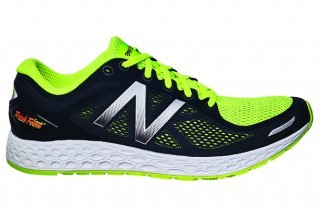
The Fresh Foam Zante 2 has undergone slight updates that have made it a better shoe.
Sometimes the equal is better, and that’s certainly the case with the performance-oriented Fresh Foam Zante 2. The original Zante turned heads (and won awards) last year for its connective feeling between foot and ground. This year’s version has been improved with a better fit around the arch. Although it remains a lightweight, nimble trainer, the second iteration of the Zante is slightly more cushioned with a slightly thicker outsole than the first. (The outsole also has more flex grooves to aid its flexibility.) The changes add to the shoe’s functional versatility and mileage range without losing any of its hi-rev performance attributes. Our wear-testers reported that it had a somewhat narrow and very athletic demeanor, but liked it because it wasn’t merely a speed shoe. “It’s not a shoe I’d take out on a 20-miler, but it certainly has the cushion and the energy for workouts and longer tempos,” one tester said.
This is the shoe for you if … You’re looking for a versatile, light and fast trainer that can double as a long-distance shoe.
Price: $100
Weights: 8.6 oz. (men’s), 7.1 oz. (women’s)
Heel-toe offset: 6mm; 23mm (heel), 17mm (forefoot)
Info: NewBalance.com
RELATED: Shoe Of The Week—Hoka One One Clayton
The post Shoe Of The Week: New Balance Fresh Foam Zante 2 appeared first on Competitor.com.
Salomon Running TV: Barcelona

The latest episode of Salomon Running TV follows Max King and Ellie Greenwood as they explore the city of Barcelona. It’s a beautiful look at big-city exploration in the best possible way—by foot.
RELATED: Salomon Running TV: Paradise Lost
The post Salomon Running TV: Barcelona appeared first on Competitor.com.
Ryan Hall's Blog
- Ryan Hall's profile
- 21 followers



